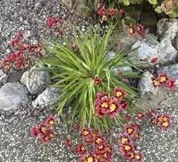I've had my garden for a little over a year now and am pleased to have my own private super bloom. With all this rain, I discovered there are swaths of freesias, colorful parrot tulips, marigolds, bearded iris, ground orchids, and gladioli galore, all of which had not bloomed last year! We also have patches of a flower that fleetingly appeared that I was unfamiliar with. It turned out to be Sparaxis tricolor, commonly known as the harlequin flower or wandflower. A monocot from the Iridaceae family, this flower is a bulb-forming cormous[1] perennial that grows in well-draining soil. It gets its name from its colorful flowers which are bi-or tri-colored with a golden center and a small ring of brown surrounded by another color, which is where it gets its nickname “Harlequin” from. The botanical name was derived from the Greek word ‘sparasso' meaning to tear which refers to the torn tips of the flower bracts. This plant is native to Southern Africa but is also found in Australia and California after escaping cultivation. [2] Here is a close-up of the flower.


[3] The plant produces loose spikes of up to five open star-shaped flowers that grow to about 2” across, 4” to 16” high. They bloom for weeks in late spring to early summer. As you can see from the image the flowers which grow above the cluster of sword-shaped leaves on wiry stalks that reach between 6 to 12” tall and comes back year after year. It does best in full sun with well-draining, loamy soil. It will not grow in the shade. It usually blooms from April to May and is insect pollinated. All species of this plant grow during wet winters like the one we just had. It likes ample water while actively growing, along with light fertilization, and is hardy in zones 9-11. It is a perfect choice for garden beds and borders, rock gardens, Mediterranean gardens, or containers. [4] When planting be sure to plant your corms 3” to 5” deep spacing them 2”-3” apart. You can propagate this plant from the bulb by keeping the corm dry after flowering. Lift the corms when the leaves have died down and store them in a dry place with a temperature ranging from 68-77 degrees Fahrenheit and then replant in the fall. You can also propagate from seed by starting them indoors in a light potting mix. The seeds typically germinate within six weeks and need good ventilation to avoid damping off. Divide the bulbs when the plant goes into dormancy at the end of the first growing season and keep them growing indoors for at least another year before replanting them outside again. Sparaxis quite often flowers in the second year from seed. [5] Do not plant until all chances of frost have passed!
Although short-lived these plants will surprise you with their tri-color blasts as long as you're observant enough to catch them during their short flowering life span!
[1] A corm is a swollen underground “geophyte” which is a perennial plant with underground food storage, and a bulb-framing plant.
[2] Wikipedia- Sparaxis tricolor
[3] Close-up image of bloom from authors plant
[4] “Gardenia- Creating Gardens
[5] North Carolina Extension Gardener Plant Toolbox

